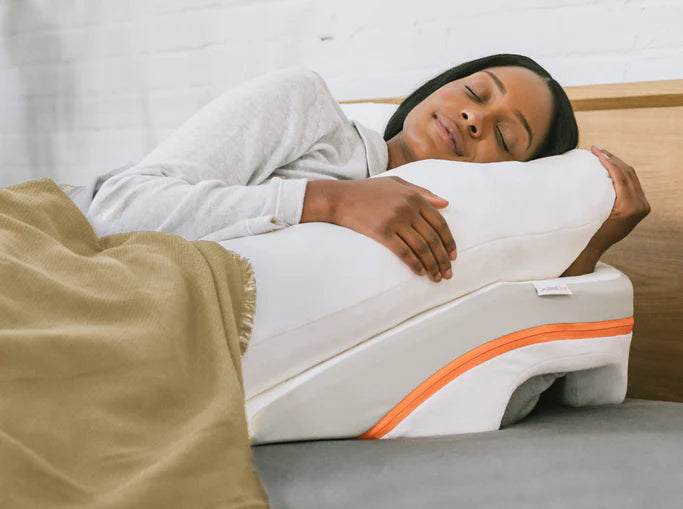Your Cart is Empty

YOUR CART
Your cart is empty!
Add your favorite items to your cart.

Baking Soda for Heartburn: How Effective is It?
December 28, 2020 6 min read
If you’ve ever experienced the radiating discomfort of heartburn, you’ve probably spent some time online looking for effective treatments, over-the-counter medications, and home remedies to help. During your research, you may have come across a surprising solution you can probably find in your pantry right this moment: baking soda for heartburn.
Does baking soda help heartburn? And how does it work? In this post, we’ll take a look at this home remedy, discuss how effective baking soda for acid reflux really is, and go over other ways you can manage your symptoms.
Use the links below to skip ahead to the section that best answers your query, or read through for a comprehensive take on the topic.
- What is Heartburn and Acid Reflux?
- Does Baking Soda Help Heartburn?
- How to use baking soda for heartburn
- Potential side effects of using baking soda for heartburn
- Baking soda do’s and don’ts
- Other Treatments for Acid Reflux
What is Heartburn and Acid Reflux?
Heartburn is a symptom that affects nearly 15 million Americans each day1. The uncomfortable feeling in your chest and throat can be triggered by certain foods, high stress levels, lack of sleep, acid reflux, and gastroesophageal reflux disease (GERD).
Heartburn occurs when the lower esophageal sphincter relaxes when it shouldn’t, allowing stomach acid and undigested foods back into the esophagus. Over time, stomach acid can start to burn and deteriorate the lining of the esophagus and contribute to other health issues if left unresolved.
What do heartburn and acid reflux feel like?
Categorized by a burning sensation in the chest, a sour taste in the mouth, and coughing, heartburn is one of the uncomfortable symptoms of acid reflux and the chronic form of the disease, GERD. Heartburn can happen as a result of these gastroesophageal diseases or happen sporadically when triggered by certain foods, medications, and lifestyle factors, such as high stress and smoking.
What are some of the symptoms of acid reflux?
In addition to the burning-chest and throat feeling of heartburn, other symptoms of acid reflux2 can include:
- Coughing
- Difficulty swallowing
- Chest pain
- Sensation of a lump in your throat
- Disrupted sleep if you experience acid reflux at night
- New or worsening asthma
When to see a doctor:If you experience heartburn symptoms more than twice a week or do not see improvement after using over-the-counter medications or home remedies, it may be time to schedule a visit with your physician to determine the best course of action.
Does Baking Soda Help Heartburn?
If you’re looking for a way to mediate your heartburn symptoms, you might want to start with your home pantry first. According to a study by the Mayo Clinic3, you can use sodium bicarbonate, also known as baking soda, for heartburn relief.
As one of the primary ingredients in over-the-counter antacids and other acid reflux medications, baking soda helps neutralize stomach acid, which in turn, limits the opportunity for stomach acid to flow back into the esophagus, causing heartburn. Like any home treatment, you’ll want to be sure you’re aware of the dosage options as well as the potential side effects of using baking soda for acid reflux and heartburn relief. In these next sections, we’ll take a look at how to use baking soda for heartburn, the possible side effects, and the do’s and don’ts of using baking soda as a remedy for heartburn.
How to use baking soda for heartburn
According to the Mayo Clinic, you can use sodium bicarbonate (baking soda) as a tablet, granule, or solution mixed with water. Before using baking soda for heartburn relief, make sure to speak with your doctor to determine if it’s the appropriate course of action for your symptoms.

If you do decide to use baking soda for acid reflux and heartburn relief, keep these recommendations from the Mayo Clinic in mind:
For sodium bicarbonate powder to relieve heartburn or sour stomach:
- Adults and teenagers—One-half teaspoonful in a glass of water every two hours. Your doctor may change the dose if needed.
- Children—Dose must be determined by your doctor.
For sodium bicarbonate tablets to relieve heartburn or sour stomach:
- Adults and teenagers—325 milligrams (mg) to 2 grams one to four times a day.
- Children up to 6 years of age—Dose must be determined by your doctor.
- Children 6 to 12 years of age—The dose is 520 mg. The dose may be repeated in thirty minutes.
For sodium bicarbonate effervescent powder to relieve heartburn or sour stomach:
- Adults and teenagers—3.9 to 10 grams (1 to 2½ teaspoonfuls) in a glass of cold water after meals. However, the dose is usually not more than 19.5 grams (5 teaspoonfuls) a day.
- Children up to 6 years of age—Dose must be determined by your doctor.
- Children 6 to 12 years of age—1 to 1.9 grams (¼ to ½ teaspoonful) in a glass of cold water after meals.
Potential side effects of using baking soda for heartburn
Every person’s body reacts to treatment differently, so you’ll need to consider the potential side effects of using sodium bicarbonate before incorporating it into your heartburn treatment solutions.
Some of the possible side effects of using baking soda for heartburn3 can include:
- Increased thirst
- Stomach cramps
- Increased risk of kidney disease
Keep in mind, these side effects typically occur only in patients who use baking soda in large doses on a regular basis. Talk to your doctor if you notice symptoms after using baking soda for heartburn relief.
Baking soda do’s and don’ts
Does baking soda help heartburn? It certainly can— however, how you use it can alter its effectiveness. Keep these do’s and don’ts in mind as you start to incorporate baking soda into your heartburn treatment plan:
- Do not take sodium bicarbonate within 1 to 2 hours of taking other medicine by mouth. Doing so may keep the other medicine from working properly.
- Do talk to your doctor if you’re on a sodium-restricted diet. Sodium bicarbonate medications contain a large amount of sodium.
- Do not take this medicine if you have any signs of appendicitis (such as stomach or lower abdominal pain, cramping, bloating, soreness, nausea, or vomiting). Instead, check with your doctor as soon as possible.
- Do not take this medicine with large amounts of milk or milk products, as doing so may increase the chance of side effects.
- Do not use baking soda for heartburn relief for more than 2 weeks or if the problem comes back often. Antacids should be used only for occasional relief, unless otherwise directed by your doctor.
- Do consult your doctor before using baking soda for heartburn relief. Your physician can help determine a recommended dosage and work with you to monitor your progress and find additional treatments as needed.
- Do not use baking soda for heartburn4 if you are pregnant.

Other Treatments for Acid Reflux
Now that you know how to use baking soda for acid reflux relief, let’s take a look at the other treatment options available to you.
Alter your diet
If you’re wondering what causes acid reflux flare ups, you may want to start by taking a close look at your diet. Certain ingredients and categories of food can exacerbate or bring on symptoms.
Here are some of the foods to avoid when managing your heartburn symptoms:
- Fried foods
- Spicy foods
- Citrus foods
- Tomatoes
- Onions
- Peppermint
- Chocolate
Alternatively, you can incorporate these foods to help your heartburn symptoms:
- Ginger
- Vegetables
- Egg whites
- Lean meats and seafood
Initiate lifestyle changes
Whether you’re dealing with mild, moderate, or bad acid reflux, it’s a good idea to implement several different solutions into your treatment plan, including making certain lifestyle changes. Maintaining a healthy weight, not smoking, and avoiding tight-fitting clothing are some of the ways you can mitigate your heartburn symptoms without using medication or surgery.
Adjust your sleeping posture
If you’re one of the 50% of acid reflux patients5 that experiences heartburn on a nightly or nearly nightly basis, we can help. MedCline’s Reflux Relief System has been clinically proven to reduce symptoms of GERD and acid reflux at night.

Engineered using the physician-recommended position for sleeping with acid reflux — on the left side, at an incline — our three-component system features medical-grade materials and is available in three different sizes for close-to-custom comfort. What’s more, our Sleep Specialists are here to support you on your search for reflux-free rest.
To learn more about our Reflux Relief System and its proven results, speak with one of our Sleep Specialists today!
References
- “Acid Reflux”, American College of Gastroenterology, https://gi.org/topics/acid-reflux/#:~:text=How%20common%20is%20heartburn%3F,the%20elderly%20and%20pregnant%20women, 28 Oct 2020
- “GERD”, Mayo Clinic, https://www.mayoclinic.org/diseases-conditions/gerd/symptoms-causes/syc-20361940, 28 Oct 2020
- “Sodium Bicarbonate (Oral Route, Intravenous Route, Subcutaneous Route)”, Mayo Clinic, https://www.mayoclinic.org/drugs-supplements/sodium-bicarbonate-oral-route-intravenous-route-subcutaneous-route/side-effects/drg-20065950?p=1, 28 Oct 2020
- “Baking Soda for Heartburn”, GI Society Canadian Society of Intestinal Research, https://badgut.org/information-centre/a-z-digestive-topics/baking-soda-for-heartburn/, 28 Oct 2020
- “Nighttime Heartburn: The Special Risks of Nighttime Heartburn”, WebMD, https://www.webmd.com/heartburn-gerd/features/special-risks-of-nighttime-heartburn#1, 28 Oct 2020
Related Product
Reflux Relief System
$249.99
Say goodbye to nighttime Acid Reflux & GERD pain without sacrificing comfort.
Subscribe
Sign up to get the latest on sales, new releases and more …
Text SHOULDER to+1 (844) 942-0170to learn more and get discounts on our Shoulder Pain Relief System.
About MedCline
MedCline was founded in 2011 by Carl Melcher, M.D, who was a life-long sufferer of GERD. Dr. Melcher wanted to help the millions of GERD patients with a natural treatment alternative utilizing positional therapy. Since development, the Reflux Relief System has been validated in 7 clinical trials. Aiming to help other medical conditions with positional therapy, MedCline has also developed a Shoulder Relief System for those who suffer with chronic shoulder pain at night. Both MedCline Relief Systems are providing much-needed relief for those suffering from nocturnal acid reflux and/or nighttime shoulder pain to get quality, restorative sleep leading to a higher health-related quality of life.
To learn more about acid reflux relief, visit our Reflux Relief System Page.
To learn more about shoulder pain relief, visit our Shoulder Relief System Page.
